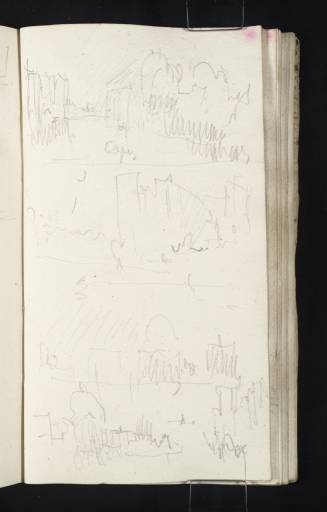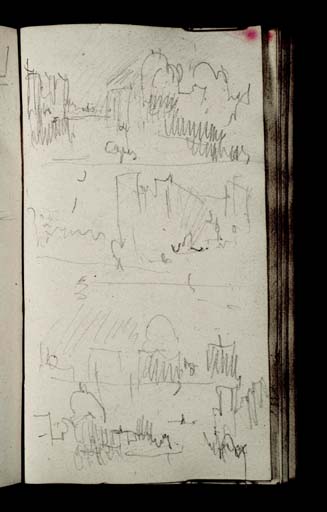Joseph Mallord William Turner Views on the Grand Canal, Venice, near Santa Maria della Salute, with a Crescent Moon 1833
Image 1 of 2
Joseph Mallord William Turner,
Views on the Grand Canal, Venice, near Santa Maria della Salute, with a Crescent Moon
1833
Joseph Mallord William Turner 1775–1851
Folio 74 Verso:
Views on the Grand Canal, Venice, near Santa Maria della Salute, with a Crescent Moon 1833
D32066
Turner Bequest CCCXIV 74a
Turner Bequest CCCXIV 74a
Pencil on white laid paper, 203 x 109 mm
Partial watermark: crescent moon with face in profile
Inscribed by Turner in pencil ‘[?L | Ca...]’ towards top centre
Partial watermark: crescent moon with face in profile
Inscribed by Turner in pencil ‘[?L | Ca...]’ towards top centre
Accepted by the nation as part of the Turner Bequest 1856
References
1909
A.J. Finberg, A Complete Inventory of the Drawings of the Turner Bequest, London 1909, vol.II, p.1015, CCCXIV 74a, as ‘Buildings at night (?)’.
Finberg later annotated his 1909 Inventory entry (‘Buildings at night (?)’): ‘3 sketches with crescent moon’.1 The Turner scholar C.F. Bell marked another copy in the same way.2 In fact there are four views, arranged one above the other down the page and separated by roughly horizontal pencil lines, albeit the lower two overlap somewhat.
The drawings between here and folio 90 recto (D32066–D32095) all show largely familiar views along the full length of the Grand Canal (roughly a reversed ‘S’-shape on the map), from its quieter north-western entrance from the Lagoon, along the northern reaches, south east to the Rialto Bridge, west to the slow turn at the south-west and then east to the south-eastern entrance from the Bacino. There are sketches along all these reaches, and it is likely that Turner was generally working from the ‘back’ of the book as foliated, towards the short run of blank pages ending (or starting) with folio 71 recto (D32060). However, the sequence is not straightforward, and may represent more than one excursion beginning or ending at the Hotel Europa (Palazzo Giustinian), opposite Santa Maria della Salute at the Bacino end, where Turner was probably staying (see the sketchbook’s Introduction). Links are made within the section to nearby subjects on adjacent pages and elsewhere, but no overall sequence can confidently be suggested; for this sketchbook’s somewhat convoluted general sequence, see its Introduction.
The relatively loose drawings here and on folio 75 recto opposite (D32067) include a waxing crescent moon (typically indicated by a single curving pencil stroke, as it were the negative of its actual effect) low towards the west, likely observed around sunset. The new moon had been on Friday 13 September, four days after Turner’s arrival in the city, so the crescent would have appeared and grown over the following few nights until its first quarter on 20 September,3 by which time the artist had presumably left for his return journey, as he was well to the north, in Innsbruck, by Monday 23 September (see the sketchbook’s Introduction). All of this goes to confirm that these particular drawings were made in the latter part of Turner’s stay of likely not much more than a week.
Of the loose Grand Canal sequence described above, the sketches between folio 76 verso and here (D32066–D32070), were likely made in reverse order, ranging from the south-western bend to the Salute. The two moonlit pages are the most rapidly rendered, as if Turner was working hastily in low light and reaching the limits of what he could usefully record from direct observation. Here, as Ian Warrell has recognised,4 three drawings show the main dome of the Salute. The one at the top is a view to the east, with buildings on both sides of the canal and the Bacino beyond. The Salute’s smaller southern dome appears to the right of the main one, with a hint of one of its flanking campanili, and the whole profile is repeated, to the right, perhaps to clarify the arrangement. There are various areas in the foreground shaded vigorously to suggest the shadows gathering on various palace façades, and some diagonal hatching behind the domes as the sky darkens. Compare the full-page views on folios 75 verso and 76 recto (D32068–D32069); other similar views are noted under the first of these.
The second subject is a view westward towards the south-western bend from about the same point, with the vertical feature at the centre likely a schematic indication of the canal frontage of the imposing Palazzo (or Ca’) Corner della Ca’ Granda, seen obliquely. Above is the first of the two crescent moons on this page; compare the full-page sketch opposite (D32067), showing much the same prospect.
The third view is similar to the first, with the scrambled verticals and rounded form at the left perhaps indicating the porch of the Dogana, just east of the Salute, or possibly the campanile and dome of San Giorgio Maggiore, across the Bacino to the east-south-east. Lastly, squeezed in at the bottom is a view west from a little east of the Salute, now shown on the left, again with a hint of the Corner palace towards the right, and the moon in the same relative position. Compare the arrangement of four more delicately rendered drawings on folio 76 verso (D32070).
Matthew Imms
May 2019
Undated MS note by Finberg (died 1939) in interleaved copy of Finberg 1909, Prints and Drawings Room, Tate Britain, II, p.1015.
Undated MS note by Bell (died 1966) in copy of Finberg 1909, Prints and Drawings Room, Tate Britain, II, p.1015.
See ‘Moon Phases 1833 – Lunar Calendar for Venice, Italy (Venezia)’, timeanddate.com, accessed 5 March 2019, https://www.timeanddate.com/moon/phases/italy/venice?year=1833 .
How to cite
Matthew Imms, ‘Views on the Grand Canal, Venice, near Santa Maria della Salute, with a Crescent Moon 1833 by Joseph Mallord William Turner’, catalogue entry, May 2019, in David Blayney Brown (ed.), J.M.W. Turner: Sketchbooks, Drawings and Watercolours, Tate Research Publication, March 2023, https://www


